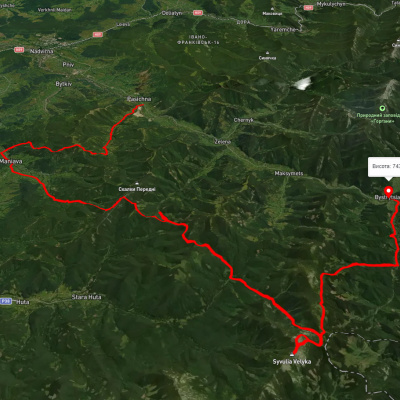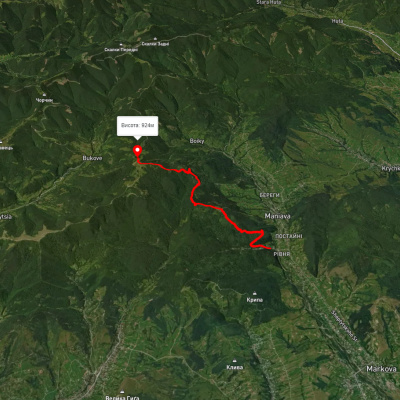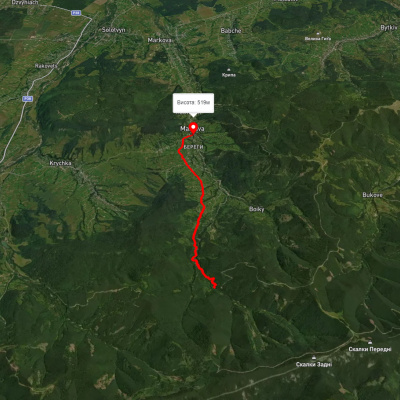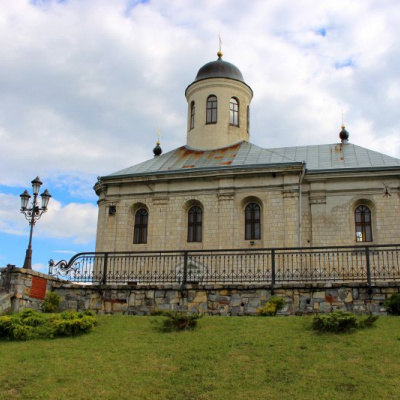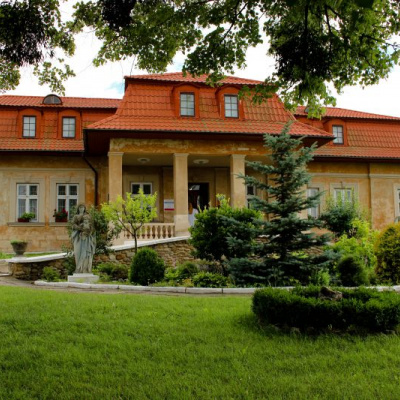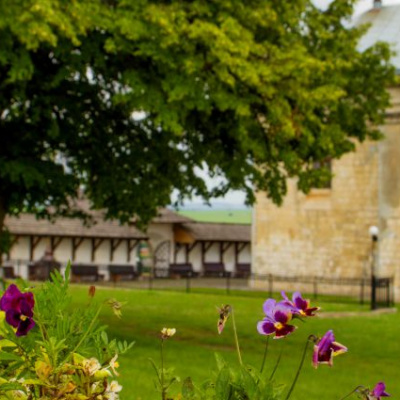It is here, in Krylos, in the heart of princely Halych, that the archaeological, architectural, and deep history of the chronicle capital is located. It was once one of the largest cities in Europe. This urban agglomeration, centered in the Princely Wing, was much larger than the cities of the ancient world, such as Babylon, Rome, and Constantinople. Galicia was one of the most powerful centers of our statehood; the Ukrainian spirit was born here and tempered in the victorious victories of Galician regiments led by wise princes. State documents were drawn up, chronicles and gospels were written, and other works of art were created. White stone churches were built that were equal to world cultural monuments.
Halych played an important role in the international trade of the Slavic world. Looking back in time, we can clearly see how closely the history and spirituality of this land are intertwined. The findings of archaeologists allowed us to see many rare items found at the Krylos settlement. On the south side, Halych was protected by a six-row line of defensive ramparts. The ramparts were built on pre-prepared wooden structures. A defensive wall was placed on the ramparts, which was supported by cages on the inner side of the rampart. Numerous ovens found indicate that the ramparts, in addition to defense, also had residential and household purposes. In particular, they were home to the military unit of the city of Halych, and food supplies for long-term defense were stored there. The rampart, with a slope height of 25 meters, a moat and a wall formed an impregnable fortress.
The unique object of Kryloska Hill is the tenth-century Galician grave, which stands as a symbol of the memory of the great builder, the unknown founder of the capital city of Halych. Mykhajlo Hrushevsky wrote: "Near Halych there was a 'Galicia Grave' and it was associated with the beginning of the city; the chronicler, mentioning this grave, promises to tell about the beginning of Halych in another place, but he did not fulfill this promise." Hrushevsky assumed that the founder of Halych, Hal (or Halychyna), could have been buried in the "Galician Grave." According to a pre-Christian custom, Russian warriors of noble families were buried in boats. Today there is a museum of the same name.
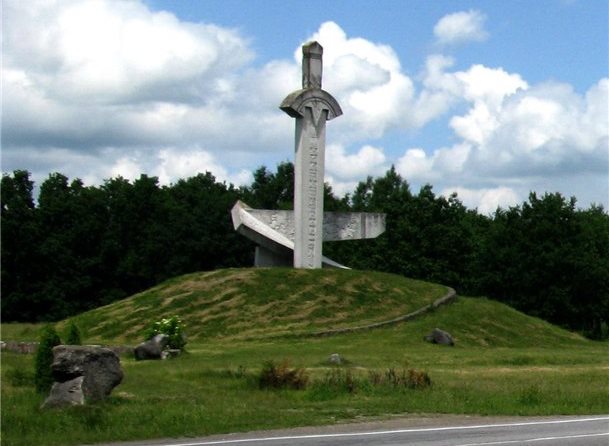
Zolotyi Tik was the place around which political, economic, and religious life was in full swing. The decrees of Galician princes were pronounced on Zolotyi Tok, ambassadors were received, and Galician soldiers set out on a campaign from here. Zolotyi Tok was the center of the economic and cultural life of the Galician state. There were churches and schools, tall stone houses of noble Galician merchants and princely dignitaries, offices of moneylenders and bankers, workshops of goldsmiths and other craftsmen. Scribes and princely scribes, jewelers, artists, doctors, and architects, noble guests, and princely men lived on Zolotyi Tok.
The
Assumption Cathedral of the 12th century was the main shrine of the glorious city of Halych. It was built by Yaroslav Osmomysl in 1157. The location of the cathedral on the Krylos settlement has become a strong evidence in the discussion about the localization of the chronicle's "city"; the impressive size of the church - 36.5×32.5 m, which among the churches of Kievan Rus at that time is second only to the size of St. Sophia of Kyiv; white stone masonry technique and rich architectural decor; a man's burial in a stone sarcophagus was found, interpreted by the researcher as the remains of the Galician prince Yaroslav Volodymyrovych (Osmomysl) who died in 1187. Based on the results of his research, Pasternak determined the time of construction of the Assumption Cathedral in Halych to be 1157.
The chapel of St. Basil the Great of the fifteenth century was built on the foundations of the twelfth-century Assumption Cathedral. It was built from the blocks of the ancient Russian church of the Assumption Cathedral of the twelfth century. For more than a century, this small church, along with its wooden superstructure and bell tower, was the central shrine of the Galician Metropolitanate. The chapel, like other churches in Galicia, was attacked by the troops of Ibrahim Shaitan Pasha. Manuscripts, old books, and documents were kept in the chapel. During the artillery shelling of 1915, the chapel was partially destroyed, and valuable documents related to the history of our region, unfortunately, were not preserved. The stone part of the monument was partially restored in 1975 and 1988. The Chapel of St. Basil, which was the first museum of the history of ancient Halych, has valuable architectural details: an altar niche and an original round window (lunette) that has been preserved from the small absida of the twelfth-century chronicle Assumption Cathedral.
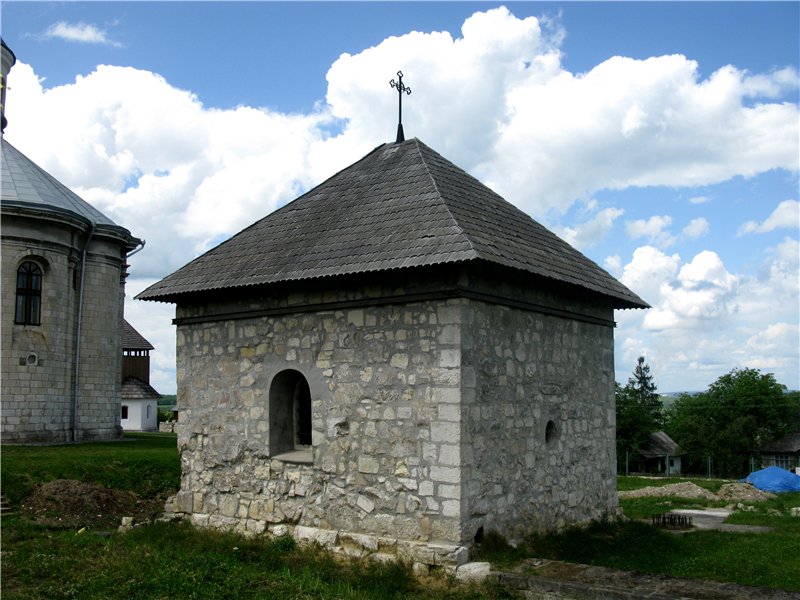
Not far from the foundation of the Assumption Cathedral, a descendant of the boyar family, Marko Shumlianskyi, built the Church of the Assumption of the Blessed Virgin Mary in 1535. He used stone blocks and plastic from the Assumption Cathedral to build the church. A tombstone of Mark Shumlansky is embedded as a memorial to the construction. Above the choirs in the church, a stone with the coat of arms of another founder has been preserved; it looks like an arrowhead with two letters A-C on its sides (Andriy Svarychovskyi).
The western portal of the church, flanked by two pilasters and crowned with a pediment, whose tympanum is decorated with a stone-carved composition "Assumption of the Virgin Mary," is of great artistic value. The restored Assumption Church shines in the sun with gilded crosses.
The iconostasis, created by Anton Manastyrskyi, a prominent master of Ukrainian painting of the early twentieth century, is a wonderful decoration of the church. A great value of the church is the Galician Miraculous Icon of the Mother of God from Krylos. In 1157, when the cathedral in princely Halych was consecrated, Prince Yaroslav Osmomysl presented the church with an icon of the Blessed Virgin Mary. Since then, she has become the patroness of the Galician princes and their descendants.
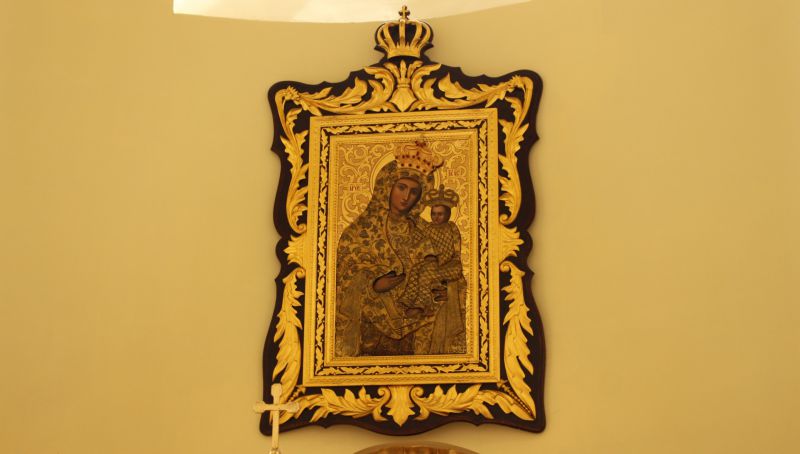
In 1773, the icon was made of silver and gilded with donations from healed Galicians. Since then, pilgrimages have been held in Krylos very often, and at least three times a year (on July 7 - the Nativity of John the Baptist, August 28 - the Feast of the Assumption of the Blessed Virgin Mary, and September 27 - the Exaltation of the Holy Cross) thousands of pilgrims from all over Galicia rush to worship the Blessed Mary and ask for her intercession. Galician metropolitans and bishops often came here, to Krylok Hill, to visit the Metropolitan Chambers. The discovery of the remains of the Cathedral of the Assumption by Yaroslav Pasternak in 1936 once again showed that the Virgin Mary continues to protect Halych-Krylos. In 2006, the icon was restored through the efforts of the parishioners, and on August 28, on the feast of the Dormition of the Blessed Virgin Mary, His Beatitude Patriarch Lubomyr Husar re-crowned the icon on the foundations of the Cathedral of the Assumption. In 2011, Metropolitan Volodymyr Viytyshyn restored the status of the pilgrimage site. With the participation of His Beatitude Sviatoslav Shevchuk, an annual pilgrimage to the Galician Miraculous Icon is held. The icon of the Blessed Virgin Mary, which was located in ancient Halych, becomes the patroness of the entire Galician region.
On the northwestern slope of the Krylos Hill, just a few hundred meters from the foundations of the Assumption Cathedral, there
is the Princely Well, where cold springs have been flowing from the ground for centuries, giving rise to streams that carry their healing waters to the chronicled river Lukva. Its water is healing because, according to legend, it gave strength and inspiration to ancient Russian warriors, made them invulnerable to enemy arrows and swords, and gave them confidence in victory.
Since the twelfth century, the chambers of Galician bishops have been standing on Kryloska Hill, and since the fourteenth century, those of metropolitans. The location is still unknown. However, under the present museum building, archaeologists have discovered traces of a complex of large wooden buildings that were built here starting in the first half of the twelfth century. The foundations of the metropolitan chambers of the seventeenth century were found nearby, in the Old Palaces tract; a wooden residence was built under Bishop Lev Sheptytsky at the end of the eighteenth century; and a stone palace was built under Bishop Skorodynsky, the building material for which was taken from the dismantled church of St. Elijah of the twelfth and thirteenth centuries. It was the residence of the Galician metropolitans and their governors, and therefore it was called
the Metropolitan Chambers.
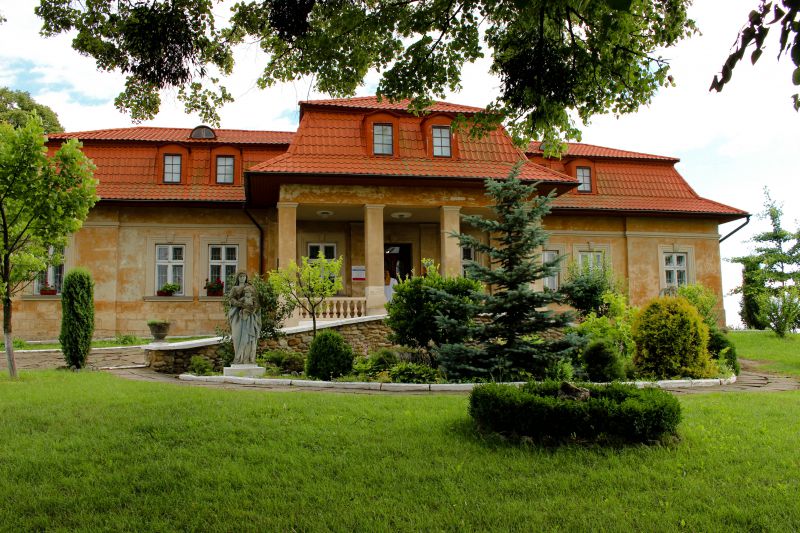
In the middle of the eleventh century, the formation of the Galician principality began. This process is connected with the activities of the founder of the Galician dynasty, Prince Rostyslav Volodymyrovych, grandson of Yaroslav the Wise. The Galician land acquired its historical name only in the second half of the twelfth century, when Halych became its capital city.
The historical arena was marked by the statesmen of Galicia Volodymyr Volodarevych, Yaroslav Osmomysl, Roman Mstyslavych, and Danylo Halytskyi, who maintained the authority of their principality in difficult conditions. In 1303, thanks to the diplomatic efforts of Prince Yurii I Lvivovych of Galicia-Volhynia, Patriarch Athanasius elevated the Galician cathedral to the status of a metropolia. It included the dioceses of Halych, Volodymyriv, Przemyśl, Lutsk, Turyv, and Kholm.
In ancient Greek sources, the new metropolis is mentioned under the number 81 in the list of all metropolitanates of the Byzantine Patriarchate. Sources of various origins allow us to only roughly reconstruct the register of Galician bishops of the mid-twelfth and thirteenth centuries. According to Ivan Krypiakevych's calculations, from the time of the foundation of the Galician diocese until the end of the thirteenth century, the Cathedral of the Assumption was occupied by at least 14 bishops, and during the existence of the Galician metropolis in the fourteenth century there were 7 more bishops. The highest hierarchs of the Orthodox Church first met in the Krylos, and at the end of the fifteenth century in St. George's Cathedral in Lviv. On June 12, 1576, the enthronement of Gideon Balaban (1565-1607) took place in the Krylos. This fact is mentioned in his own handwritten note on a page of the twelfth-century parchment Gospel, which he said came from princely Halych. The handwritten Galician Gospel of 1144 later came into the hands of the Metropolitans of Suceava, and from there to Moscow, where it is kept in the Synodal Library. In 1668, Joseph Shumlyansky was appointed Bishop of Lviv, Halych and Kamianets-Podilsky. In the initial period of 1669-1674, 60 candidates for the priesthood were ordained in the Assumption Cathedral of the Krylos Monastery, including the local rector, Father Ilya.
On November 21, 1680, the solemn consecration of Innocent of Vinnytsia as bishop took place in Krylos, performed by Bishop Joseph Shumliansky, Bishop Joseph Voloshchanovsky of Mukachevo, and Archimandrite Varlaam Sheptytsky of Univ, with the participation of many clergy and nobles.
The ordination of candidates for the priesthood in the Krylos monastery resumed on August 15, 1687, along with the appointment of a new local parish priest, Father Daniel. By October 1, 1708, 567 priests, deacons, hierodeacons, and hieromonks for many localities and monasteries were ordained in the Galician Cathedral of the Assumption of the Virgin Mary. During the Tatar attack, archival documents about Halych were lost. Until 1946, crowded pilgrimages to the Galician Miraculous Icon of the Mother of God from Krylos were held in Krylos.
And the year 2011 is significant! Krylos was granted the status of a pilgrimage site, where in 2011, 2012, 2013, and 2014 Patriarchal pilgrimages were held with the participation of Patriarch Sviatoslav Shevchuk on the first Sunday of August. Ancient Halych is his canonical territory. Of particular importance are those places approved by the Church, such as Krylos. The successor of the head of the UGCC, Lubomyr Husar, His Beatitude Sviatoslav Shevchuk, has been leading the Liturgy during the annual patriarchal pilgrimages to the Galician Miraculous Icon at the pilgrimage site on Krylos Hill since 2011.
In summarizing the above, I would like to use the words of Patriarch Sviatoslav Shevchuk, who, speaking about the significance and role of the visits of the heads of the UGCC to Halych-Krylos, repeatedly emphasized that "the voice of the faith of our ancestors" did not accidentally call us to this ancient city of Halych, which became the heir of the Kyivan state and church, and the foundation for the construction of Ukrainian statehood, the Christian and European choice of the Ukrainian people, who remained faithful to the faith of their fathers..." In general, all the visits of the supreme hierarchs of the UGCC to Halych played an important role in the revival of historical justice for ancient Halych, and the fact that today Ancient Halych is directly subordinate to the Kyiv-Halych Major Archbishop Sviatoslav Shevchuk. On August 3, 1014, during the Patriarchal Pilgrimage for Peace in Ukraine, which took place in Krylos, a historic moment was accomplished in the ancient Galician land. For the first time in many years, the Auxiliary Bishop of Ivano-Frankivsk of the UGCC, His Grace Kir Josaphat, was ordained as an Episcopalian. In his address to the newly ordained bishop, Patriarch Sviatoslav wished that Ancient Halych would become a special home for him.




